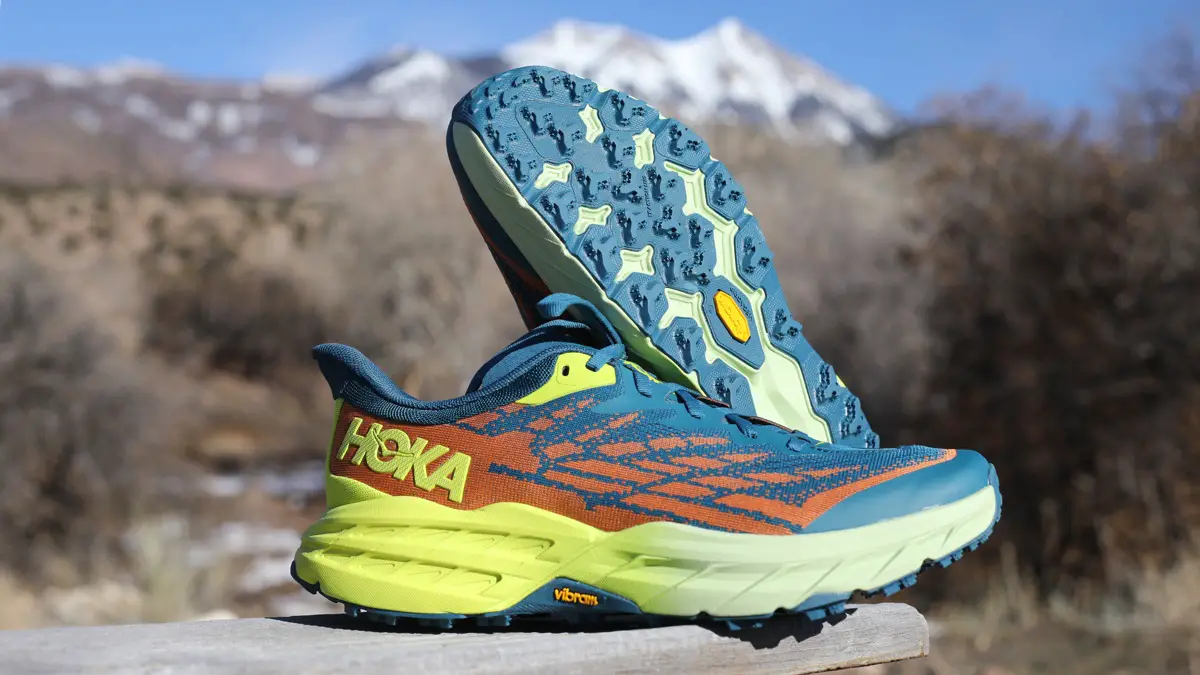To choose the right trail running shoes for technical terrain, consider factors such as traction, stability, cushioning, and durability. Having shoes with aggressive outsoles, sturdy construction, ample cushioning, and protective features like toe guards and rock plates will enhance your performance on challenging trails.
Trail running can be an exhilarating and adventurous sport, but it also comes with its own set of challenges. If you plan to tackle technical terrain, having the right pair of trail running shoes is crucial. These shoes are specially designed to provide the necessary traction, stability, and protection needed to navigate rugged and unpredictable trails.
With a wide range of options available in the market, choosing the perfect shoes can seem overwhelming. However, by considering important factors like traction, stability, cushioning, and durability, you can find the ideal pair that will enhance your performance and keep you comfortable and protected on any technical trail.
Importance Of Having Proper Footwear
Choosing the right trail running shoes for technical terrain is crucial for optimal performance and comfort. The importance of having proper footwear cannot be overstated. The right shoes can significantly impact your running experience, enhancing your performance and reducing the risk of injuries.
When running on technical terrain, such as uneven surfaces or rocky paths, having shoes with strong grip and stability is essential. These features provide the necessary traction and support to navigate through challenging terrains without compromising your balance. Additionally, shoes with adequate cushioning and flexibility will absorb shock and reduce the impact on your feet and joints.
By providing protection and stability, the right trail running shoes can help prevent common running injuries, such as sprains, strains, and blisters. So, make sure to carefully consider your needs and the terrain you’ll be running on when choosing your trail running shoes.
Understanding The Demands Of Technical Terrain
Choosing the right trail running shoes for technical terrain requires understanding the demands of such surfaces. Technical terrain is characterized by uneven surfaces and various obstacles. The shoes you select should be able to handle these challenges effectively. Uneven surfaces can put strain on your feet and ankles, so it’s important to find shoes with proper cushioning and support.
Additionally, the shoes should have good traction to navigate obstacles such as rocks, roots, and loose gravel. It’s also crucial to consider the variable trail conditions, as the terrain can change from soft and muddy to hard and rocky. To make the right choice, evaluate the shoe’s durability, breathability, and weight.
By considering these factors and finding the right balance of features, you can select the perfect trail running shoes for technical terrain.
Essential Features To Look For In Trail Running Shoes
Trail running shoes for technical terrain require specific features to ensure optimal performance. One essential feature to look for is traction and grip, which provides stability on uneven surfaces. The shoes should also offer stability and support to prevent injuries, especially during intense runs.
Additionally, durability and protection are crucial to withstand the harsh conditions of trail running. The shoes should be able to withstand debris, rocks, and water without compromising performance. When choosing the right trail running shoes, it’s important to prioritize these features to enhance your running experience.
So, consider the traction and grip, stability and support, as well as durability and protection when selecting your trail running shoes for technical terrain.
Traction And Grip
Choosing the right trail running shoes for technical terrain starts with considering traction and grip. The outsole materials and patterns play a crucial role in providing the necessary grip. Opt for shoes with deep lugs and multidirectional treads to tackle diverse terrains.
Deep lugs ensure a secure grip on slippery surfaces, while multidirectional treads help with quick changes in direction. These features enhance stability and reduce the risk of slipping, improving overall safety. Additionally, the choice of outsole materials is essential. Look for durable rubber compounds that offer excellent grip without compromising on durability.
By carefully considering the traction and grip features, you can confidently navigate technical terrain, enjoying your trail running adventures to the fullest.
Stability And Support
Choosing the right trail running shoes for technical terrain requires considering stability and support. The midsole cushioning and responsiveness impact the shoe’s performance. The heel-to-toe drop and pronation control are crucial for a smooth running experience. Ankle collar and arch support provide added stability and prevent injuries on uneven surfaces.
It’s important to find shoes that offer a balance of comfort and protection. Taking into account these factors will ensure a successful trail running experience on challenging terrain. So, paying attention to stability, cushioning, pronation control, ankle collar, and arch support is key to choosing the right trail running shoes.
Durability And Protection
Choosing the perfect trail running shoes for technical terrain involves considering factors like durability and protection. One essential feature to look for is a protective toe cap which shields your toes from rocks and other hazards. Additionally, a rock plate or shank provides extra protection by minimizing discomfort from sharp objects underfoot.
Another crucial consideration is water resistance, ensuring your feet stay dry on wet trails. These features contribute to the overall durability and protection of trail running shoes, allowing you to confidently conquer challenging terrains. So, when choosing the right trail running shoes, prioritize durability, protection, and water resistance for a comfortable and enjoyable trail running experience.
Understanding Your Running Style And Foot Mechanics
Understanding your running style and foot mechanics is crucial when choosing trail running shoes. Pronation and supination refer to how your foot naturally rolls inward or outward during running. This affects how your weight is distributed and impacts shoe selection.
Another factor to consider is your arch type, whether you have high, low, or neutral arches. Determining your arch type helps identify the right shoe with appropriate support. Gait analysis involves observing how you walk and run to assess your overall movement patterns and foot strike.
This analysis aids in selecting shoes that cater to your specific needs. By understanding your running style, foot mechanics, pronation, supination, arch type, and gait analysis, you can make informed decisions when choosing trail running shoes for technical terrain.

Credit: www.outdoorgearlab.com
Trying Them On And Testing For Fit
Choosing the right trail running shoes for technical terrain requires trying them on and testing for fit. Sizing and toe room are crucial factors to consider. Remember to check the lace systems and adjustability options to ensure a secure and comfortable fit.
Once you have found a potential pair, taking them for a test run is essential. This allows you to evaluate their performance and how they handle the specific challenges of technical terrain. It’s important to choose shoes that not only fit well but also provide the necessary support and traction for your running style and the terrain you will encounter.
By following these guidelines, you can find the perfect trail running shoes for technical terrain and enhance your running experience.
Trail Running Shoe Selection Based On Terrain Type
Trail running shoes for technical terrain require careful consideration based on the type of terrain. Mud and wet terrain demand shoes with superior grip and water-resistant features. Look for deep lugs and a waterproof or water-repellent upper for optimal performance.
For rocky and technical terrain, focus on shoes with a protective rock plate, reinforced toe cap, and sturdy outsole for enhanced stability and protection. A flexible yet supportive midsole is crucial for navigating uneven surfaces. When dealing with hilly and mountainous terrain, prioritize shoes with excellent traction and a responsive midsole for efficient uphill and downhill running.
Consider the weight of the shoes as well to ensure your energy is not wasted on unnecessary weight. By choosing trail running shoes specifically designed for the terrain you’re tackling, you can optimize your performance and minimize the risk of injuries.
Considerations For Specific Conditions And Preferences
When selecting trail running shoes for technical terrain, it’s crucial to consider specific conditions and preferences. In hot and dry climates, opt for shoes that offer breathability and moisture-wicking properties to keep your feet cool and dry. For cold and winter conditions, choose shoes with insulation and a grippy outsole to provide traction on slippery surfaces.
If you prefer lightweight and minimalist shoes, look for options that offer a balance between cushioning and responsiveness. Additionally, consider the durability and protection provided by the shoes to ensure they can withstand the rugged terrain. By carefully considering these factors, you can choose the right trail running shoes that will enhance your performance and comfort on technical terrain.
Tips For Finding The Right Trail Running Shoe For You
Finding the right trail running shoes for technical terrain can be overwhelming. However, there are helpful strategies to follow. Start by consulting experts and professionals who can offer valuable insights and recommendations. Reading reviews and comparisons from experienced runners can also provide guidance.
Trying out different brands and models is crucial to finding the right fit and features that meet your specific needs. Consider factors such as traction, stability, durability, and comfort. By actively exploring various options and seeking expert advice, you can make an informed decision when choosing your trail running shoes for technical terrain.
Remember, selecting the right shoes will significantly enhance your overall trail running experience and performance.
Frequently Asked Questions For How Can I Choose The Right Trail Running Shoes For Technical Terrain?
What Is Technical Terrain In Trail Running?
Technical terrain in trail running refers to challenging and complex surfaces such as rocky, uneven, or steep paths.
How Do I Know What Trail Running Shoes To Buy?
To find the right trail running shoes, consider factors like terrain, cushioning, stability, and fit. Research and try on different brands and models to determine which ones meet your specific needs.
Can Trail Running Shoes Be Used For Road Running?
Yes, trail running shoes can be used for road running without any issues.
What Is The Difference Between Trail Shoes And Trail Running Shoes?
Trail shoes and trail running shoes are essentially the same thing, designed specifically for running on rugged terrain.
Conclusion
With so many options available, choosing the right trail running shoes for technical terrain can seem overwhelming. However, by considering a few key factors, you can find your perfect match. First, examine the tread pattern and depth to ensure it provides adequate traction on rugged surfaces.
Next, assess the shoe’s stability features, such as a firm midsole and a secure heel counter, which will help you navigate uneven terrain with confidence. Additionally, consider the shoe’s cushioning level and responsiveness, keeping in mind that a balance between comfort and agility is essential for technical trails.
Finally, don’t forget to try on different shoes and pay attention to how they feel on your feet. Remember, finding the right trail running shoes for technical terrain is a personal process that requires you to consider your unique needs and preferences.
By following these guidelines, you’ll be well on your way to conquering the trails with grip, stability, and comfort.



